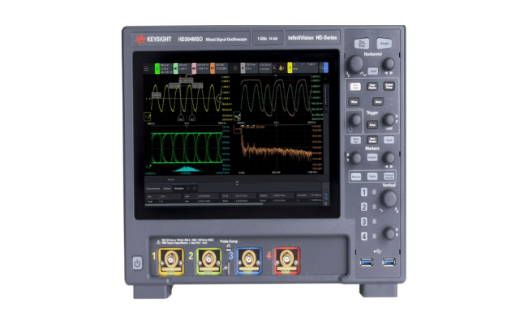The oscilloscope technology enhances signal testing and streamlines debugging in complex electronic environments.
Keysight Technologies, Inc. has launched the InfiniiVision HD3 Series, a oscilloscope featuring a 14-bit analog-to-digital converter (ADC). This device provides four times the signal resolution and reduces the noise floor by half compared to typical general-purpose oscilloscopes. Engineered from scratch, it incorporates a custom application-specific integrated circuit (ASIC) and advanced memory architecture. This design helps engineers swiftly pinpoint and address signal issues across various applications.
As device and component designs grow in complexity and utilize ever-smaller signals, engineers face the challenge of tracing multiple signals simultaneously to detect minuscule signal errors that could indicate design flaws or hardware defects. An oscilloscope capable of measuring the smallest and most sporadic signal glitches is crucial for optimizing product quality and yield.
The Keysight HD3 Series oscilloscope addresses these needs by offering the highest vertical resolution with its 14-bit ADC and a low noise floor of 50 µVRMS, enabling the detection of subtle signal anomalies. With bandwidth options ranging from 200 MHz to 1 GHz, the HD3 Series enhances digital debugging and reduces time to market.
The oscilloscope delivers precision with its 14-bit ADC resolution and low noise floor, coupled with a 1.3 M waveforms per second update rate, enabling swift debugging. It includes a custom-built ASIC, offering higher sample rates and more memory, along with high vertical resolution and functions like mask, zone, and serial decode. The device also boasts deep memory capabilities for enhanced measurement and analysis, and a new interface that supports full resolution on every channel, various bandwidth options, HD mode, and customizable thresholds.
Test automation is enhanced by the new fault hunter software, which automatically analyzes glitches and other issues, freeing engineers to concentrate on other tasks. Instant software upgrades provide immediate enhancements in bandwidth, memory, and features through software licensing, allowing for ongoing updates as design needs evolve without needing to return the equipment.
Original article source:https://www.electronicsforu.com/news/oscilloscope-speeds-up-debugging
FAQ
1.What is an oscilloscope, and how does it help in debugging?
An oscilloscope is an electronic test instrument that graphically displays voltage signals over time. It helps in debugging by allowing engineers to visualize waveforms, detect anomalies, and measure signal characteristics such as amplitude, frequency, and noise.
2.How does an oscilloscope help in identifying signal issues?
Oscilloscopes allow you to capture and view live signals, making it easier to identify glitches, signal integrity issues, and timing problems. By analyzing waveforms, you can pinpoint where the signals deviate from expected behavior.
3.What features of an oscilloscope make it effective for debugging?
Key features include high bandwidth, fast sample rates, and powerful triggering capabilities. These allow the oscilloscope to capture high-speed events and accurately display transient or periodic signal behaviors for better analysis.
4.How does triggering improve debugging with an oscilloscope?
Triggering allows you to capture specific events, such as glitches or sudden voltage spikes. This helps isolate the problem and focus only on relevant parts of the signal, speeding up the debugging process by avoiding unnecessary data.
5.Can an oscilloscope help with digital signal debugging?
Yes, many oscilloscopes support mixed-signal debugging, allowing you to observe both analog and digital signals. This is useful for systems that combine both types of signals, helping you debug issues like incorrect data transmission or timing errors.
6.How does the oscilloscope’s bandwidth affect its debugging capabilities?
The bandwidth of an oscilloscope determines how well it can capture high-frequency signals. Higher bandwidth enables better resolution of fast transitions and shorter signal pulses, which are often critical for debugging high-speed circuits.
7.What role do automated measurements and analysis tools play in speeding up debugging?
Modern oscilloscopes offer automated measurements and analysis tools, such as FFT (Fast Fourier Transform) analysis, jitter analysis, and serial decoding. These features quickly provide insights without requiring manual calculations, accelerating the overall debugging process.
